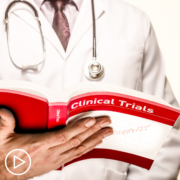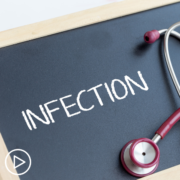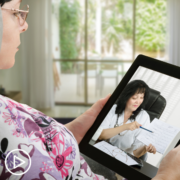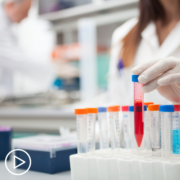Multiple Myeloma Archives
Plasma cells are cells in the immune system that make antibodies, which help the body fight infection and disease. Multiple myeloma cells are abnormal plasma cells (a type of white blood cell) that build up in the bone marrow and form tumors in many bones of the body.
More resources for Multiple Myeloma from Patient Empowerment Network.
How Will Telemedicine Impact Multiple Myeloma Clinical Trials?
How Will Telemedicine Impact Multiple Myeloma Clinical Trials? from Patient Empowerment Network on Vimeo.
What impact has telemedicine had on multiple myeloma clinical trials, and what effect will it have on trials in the future? Expert Dr. Joseph Mikhael explains the impact of telemedicine early on in the COVID-19 pandemic, how he uses virtual visits with his patients currently, and the role and benefits of telehealth in the future of myeloma care.
See More From the Myeloma TelemEDucation Empowerment Resource Center
Related Resources:
Transcript:
Dr. Joseph Mikhael:
COVID-19 has impacted our lives in just about every way imaginable, and in multiple myeloma, sadly has very much impacted our ability to conduct clinical trials. Thankfully, now that we are out of the immediate acute phase when many trials were suspended, we actually have been able to work around this in general, where now we’ve been able to re-introduce studies and bring in new studies, of course, and we can do so in a more careful manner. Many of our clinical trials now are allowing intermittently to have telemedicine visits, which reduces the traffic for patients and makes it a little bit smoother. Some of the questionnaires and the things that we used to have to fill out on paper or physically in-person now can be done electronically, and so I think in many respects, we’ve really overcome most of the barriers so that we can continue the outstanding work and clinical trials to provide options for our patients that were not available before.
And looking to the future, I hope, even paradoxically in some way that this may — now that we’ve developed a more sophisticated telemedicine platform — it may allow us to do more and perhaps reach patients that may not have been reached before, there are already studies and trials that are being done through telemedicine, not necessarily a drug trial but quality of life studies, engagement studies, educational studies, different ways that we can enhance a patient’s experience and investigate better ways of doing things now that we can do so more fully electronically.
So, when I think of telemedicine and the future in multiple myeloma, I think it will continue to have a role in the long term. I think, much like people think that there will be more virtual meetings, I think we all want to get back to in-person meetings of various types and sizes and shapes, there will always be a component of virtual, and I can think even in my own practice and some patients that have quite a long drive to come down to see me, that they will still have to have face-to-face visits, but intermittently when the things are going well, follow-up like visits where the discussion may be limited.
I think there will be a role for this so that we can leverage the best of telemedicine and the best of in-person medicine so that the patients can receive the best care possible.
What Multiple Myeloma Populations Will Benefit From Telemedicine?
What Multiple Myeloma Populations Will Benefit Most From Telemedicine? from Patient Empowerment Network on Vimeo.
Which multiple myeloma patients will benefit most from telemedicine visits, and which patients can get more from in-person visits? Dr. Joseph Mikhael shares information on how to ensure the best myeloma care even during pandemic restrictions and how in-person visits have adjusted to limit COVID exposure risk.
See More From the Myeloma TelemEDucation Empowerment Resource Center
Related Resources:
Transcript:
Dr. Joseph Mikhael:
When it comes to making a decision around, do I need to go into the clinic or can I do this as a telemedicine visit, of course, that has to be discussed with the healthcare team, but a few things we’ve learned through this pandemic.
And perhaps one of the most important things we’ve learned through the pandemic is that controlling one’s disease, controlling one’s myeloma is critical to protecting people against COVID, sadly, many of our patients who have struggled the most with COVID are those who had very active myeloma. So, we emphasize the importance of making sure that one continues to receive the best myeloma care possible, and very often that is going to involve an in-person visit, not only for discussion, but, of course, for the actual receiving of treatment. Secondly, I think it’s very important for us to note that we really have not seen significant spread of COVID or almost any infection within our hematology-oncology clinics, we’ve taken particular precaution around this area. So, this is different than someone maybe going out to a more public place where the risks may be higher. And so, we try to reassure our patients that coming into clinic actually is really not a high-risk situation and, in fact, perhaps lower risk than ever in light of the fact that many of our waiting areas and places where we have patients have been restructured and have fewer patients because of telemedicine visits.
And then thirdly, and very importantly, whether it’s telemedicine or in-person, it’s really important to maintain open, honest, and clear communication with the healthcare team. And if that is felt that it’s being done to a certain extent in telemedicine, fantastic, but there are situations where it’s challenging and difficult and really must be face-to-face. And so I would want to encourage my patients not to be afraid to go in to receive treatment and to meet with their healthcare team. These are generally very safe places that we take special precautions to ensure their patients can receive the best care possible.
Are There Any Barriers for Multiple Myeloma Patients Using Telemedicine?
Are There Any Barriers For Multiple Myeloma Patients Using Telemedicine? from Patient Empowerment Network on Vimeo.
Along with all the benefits of multiple myeloma care via telemedicine, there are some obstacles that providers run into as well. Myeloma expert Dr. Joseph Mikhael details his experience with telehealth barriers in caring for his patients.
See More From the Myeloma TelemEDucation Empowerment Resource Center
Related Resources:
Transcript:
Dr. Joseph Mikhael:
So there are several limitations to telemedicine, despite better technology and camera strength and Wi-Fi, and we’re removing all those distractions, it really is limited by not being able to physically be present with a patient, which means we can’t examine patients, which means we can’t hug our patients, I’m a hugger as an oncologist, I like to get close to my patients, and then of course, there are those things that don’t always convey themselves easily over a camera or a computer.
The emotion in the room, the tension, the fear, many of my patients experience fear being cancer patients, and so telemedicine can be very helpful when we have more straightforward follow-ups and questions, but initially building a bond with the patient and having very considerable discussions about one’s treatment and on symptoms, it is always going to be limited in a telemedicine capacity
What Are Best Practices for Multiple Myeloma Patients Utilizing Telemedicine?
What Are Best Practices for Multiple Myeloma Patients Utilizing Telemedicine? from Patient Empowerment Network on Vimeo.
What are some ways that patients and providers can make the most of multiple myeloma telemedicine visits? Dr. Joseph Mikhael shares things that he has found helpful in interacting via telehealth visits with his patients and how he tries to approach different types of visits.
See More From the Myeloma TelemEDucation Empowerment Resource Center
Related Resources:

Will Telemedicine Be an Advantage for Multiple Myeloma Patients? |

What Multiple Myeloma Populations Will Benefit from Telemedicine? |

How Will Telemedicine Impact Multiple Myeloma Clinical Trials? |
Transcript:
Dr. Joseph Mikhael:
Well, the best practices for telemedicine are really going to depend on the nature of the clinic, the way the provider likes to interact with their patients, and the way the patients like to interact with them. I think one of the beauties of the multiple platforms we have is that we can leverage them, that beautiful connection that we develop between a physician or a provider and their patient, we can continue obviously not to the same extent that using electronic means, and so I’ve really tried to make sure that I don’t look at this as a half visit or as a partial visit.
I think psychologically is my first important tip that we look at this as another very important physician-patient interaction. Secondly, I try to make sure that my patients are comfortable with this modality, that we’ve had time to work through the technology, so we’re not worrying about who’s on mute, who’s not on mute, so that when we discuss things, we can discuss things properly, and that thirdly, we as much as possible, try to engage a full visit, whether a family member is going to be with the patient, whether a nurse practitioner, a nurse or pharmacist is going to join me on this side, that we really try to reproduce what we know works well in the clinic.
So, that the patient can feel comfortable so that they can be heard, because sometimes it’s difficult when you’re on the other side of a computer or phone to really be heard.
So psychologically, being prepared for this and getting into the specifics of making sure we’re comfortable with the technology, and then thirdly, really as much as possible, trying to reproduce that magic that we feel like when we have a face-to-face interaction.
Will Telemedicine Be an Advantage for Multiple Myeloma Patients?
Will Telemedicine Be An Advantage for Multiple Myeloma Patients? from Patient Empowerment Network on Vimeo.
With the rise of telemedicine into multiple myeloma care options, unforeseen benefits have occurred along with those that are well-documented. Dr. Joseph Mikhael shares what he’s experienced in caring for his patients.
See More From the Myeloma TelemEDucation Empowerment Resource Center
Related Resources:
Transcript:
Dr. Joseph Mikhael:
The pandemic, both in the short term and the long term has really revolutionized much of what we’re doing in medicine, telemedicine is one of those areas. It’s, despite all the challenges that we faced of social isolation, it really has given us an opportunity to not only see patients who we may not have already seen but also allow us to develop a relationship with patients where we can determine when is it best and needed truly to be seen in-person. And when can we do visits by telemedicine, allowing the patient to have less travel time and the challenges of coming to the clinic and allowing us to keep our clinics limited to those patients that genuinely need to be seen face-to-face. So it’s really now been a wonderful adjunct to the way we care for patients, doing so continuously in a human fashion, but also leveraging the technology and that we can use for this.
Are There Limitations of Telemedicine for Multiple Myeloma Patients?
Are There Limitations of Telemedicine for Multiple Myeloma Patients from Patient Empowerment Network on Vimeo.
What have some multiple myeloma patients seen in terms of limitations of telemedicine? Myeloma expert Dr. Sarah Holstein details some obstacles some of her patients have gone through – and share some benefits that she’s experienced with her patients.
See More From the Myeloma TelemEDucation Empowerment Resource Center
Related Resources:

How Can Myeloma Patients Reduce Infection Risks During Medical Appointments? |

|

Will Telemedicine Mitigate Financial Toxicity for Myeloma Patients? |
Transcript:
Dr. Sarah Holstein
So, I’ve actually found that there’s very few limitations. One of course is access to the appropriate technology to be able to do telemedicine, so there are a few patients that I really just need to do telephone visits with, and I think those are a little bit more difficult there’s just something about being able to see somebody on the screen that you kind of get an immediate sense for how they’re doing, and that’s a bit lost when it’s just via telephone. So, for those patients who either because of not having fast enough Wi-Fi service based on where they live, or just not having the access to the technology, video cameras, phones with videos in them, that can be a restriction.
But otherwise, I think this has been a really good thing for my patients, and it’s given me a glimpse into their home life, I can’t tell you how many times I’ve had dogs or cats wander into the telehealth appointment, and usually we stop to talk about those dogs or cats, and it’s just a way to really get to know my patients a little bit better, it’s allowed me to see more family members because many times, not all the family members would be able to come for an in-person visit, but now they’re at home and so it’s given me more insight into how my patients live.
Will Telemedicine Mitigate Financial Toxicity for Myeloma Patients?
Will Telemedicine Mitigate Financial Toxicity for Myeloma Patients? from Patient Empowerment Network on Vimeo.
With the entry of telemedicine into the multiple myeloma care toolkit, there are some real benefits to the cost of care visits. Dr. Sarah Holstein outlines some of the financial benefits that she’s seen for her patients – and how the logistics of scheduling appointments has changed.
See More From the Myeloma TelemEDucation Empowerment Resource Center
Related Resources:

Will Telemedicine Be a Long-Term Survival Tool for Myeloma Patients? |

|

|
Transcript:
Dr. Sarah Holstein
So, there’s definitely quite a bit of financial toxicity associated with being a patient who has myeloma. There of course is the cost of the drugs and treatments themselves, but there’s also the personal time cost. So, the cost that it takes to perhaps take a half day off of work or a full day of work to see your provider in person, and the flexibility that telemedicine allows, namely being able to do your appointment from either the privacy of your own home or in some cases the privacy of your own office or even your own car, really allows patients to keep going about their business without having to take all that time off to come travel. There’s the cost associated with gas mileage in some cases, costs associated with parking, although thankfully, that’s not a cost that’s occurred here at Nebraska Medicine. But I certainly know that that can be an issue at other institutions and can really add up for patients over time. So, it’s really been so much easier for patients to get in to see me even when my schedule is fairly full, because they don’t have to think about, “Well, I don’t need to leave work an hour, try to go over my lunch break,” or something like that, they can just schedule it and do it from their office.
I think it’s been a good thing for patients and hopefully is cutting down costs for them.
How Can Myeloma Patients Reduce Infection Risks During Medical Appointments?
How Can Myeloma Patients Reduce Infection Risks During medical appointments from Patient Empowerment Network on Vimeo.
How much of a risk are medical appointments for multiple myeloma patients? Myeloma expert Dr. Sarah Holstein explains infection risks of infusion appointments versus clinic visits – and shares how she’s helped to ensure safe visits for her patients.
See More From the Myeloma TelemEDucation Empowerment Resource Center
Related Resources:

|

Will Telemedicine Mitigate Financial Toxicity for Myeloma Patients? |

|
Transcript:
Dr. Sarah Holstein
So, I think the risk associated with going in to get your blood drawn is probably quite low. All health care providers are going to be masked. The time that is spent getting the blood actually drawn is quite low and generally are in and out. So, for what I’ve tried to do for patients is of course to minimize unnecessary lab draws and if possible, try to coordinate them with other tests that are being done that day or other visits that are being done that day, and the infusion appointments, of course are necessary. But again, I think the risk of going to an infusion appointment is quite low, where I think the risk gets a little bit higher is when you’re sitting in waiting rooms of clinics and some people are slipping their masks off to drink coffee or to do other things, like that. And so, on my end, what I’ve tried to do to reduce risk is to utilize telehealth appointments as much as possible so that patients aren’t spending time in waiting rooms, but again, some of the necessary evils are just that you have to get some labs drawn to make sure that it’s safe to administer chemotherapy to make sure that the treatment is working, and you also have to go to infusion appointments.
I will say I’m pretty strict about masking, so if I have a patient perhaps come in for an in-person visit and it’s the type of mask where it’s slipping off of their face as they’re talking, and we’ve all experienced those types of masks that fit fine until you actually start talking. I’ll get a replacement mask for them to really make sure that everybody, the healthcare providers, the team as well as the patient, and if there’s a family member with them or a safest can be, and that includes wearing a properly-fitting mask.
How Will the Pandemic Impact Multiple Myeloma Trials?
How Will the Pandemic Impact Multiple Myeloma Trials? from Patient Empowerment Network on Vimeo.
How has the COVID-19 pandemic changed multiple myeloma clinical trials, and how can telemedicine play a role in trials? Dr. Sarah Holstein shares her perspective on how trials were altered and her suggestions for improvements in trials.
See More From the Myeloma TelemEDucation Empowerment Resource Center
Related Resources:

Will Telemedicine Be a Long-Term Survival Tool for Myeloma Patients? |

|

Are There Limitations of Telemedicine for Multiple Myeloma Patients? |
Transcript:
Dr. Sarah Holstein
Early on, I was very concerned about the ability to conduct clinical trials during the pandemic, early on, at least in our institution, and I know that there were many others across the country, there was a lot of concern about really limiting what was considered by the IRB (Institutional Review Board) to be an essential contact. They perhaps placed an emphasis on later phase clinical trials and thought that the earlier phase clinical trials weren’t necessarily proving to be a benefit for patients and therefore shouldn’t be opened, and I would have to say that that was not what my thought was. I really think that all clinical trials, whether it’s a Phase I, Phase II, or Phase III or of utmost importance to our patients and are important for their care. So again, early on, I was very concerned about limiting the access of clinical trials to patients. As the pandemic has continued and it’s become clear that this is going to be life as we know it for unfortunately, quite some time, I know at our institution, we’ve really tried to be as safe as possible, but all clinical trials are open and we’re allowed to enroll, I think there still is room for improvement with respect to how telemedicine is incorporated into clinical trials, and whether or not we can do things like allowing patients to get their study labs drawn closer to home as opposed to traveling to the academic center, so I think there continues to be room for improvement for really trying to minimize the amount of traveling that people do, and therefore the amount of potential exposure that patients have.
We still are not routinely using telemedicine for the clinical trial visits, that most of those are still in person. And I think depending on the specific trial, that is probably appropriate if you have a new agent and a lot of what you’re looking for is evidence of toxicity, I think it is important to be able to evaluate the patients in person and really be able to conduct a normal physical exam, having said that though, if a patient’s on a clinical trial where they’re receiving more standard of care, and perhaps it’s in a maintenance phase of a study, I think being able to utilize telehealth for some of those more routine visits would really be beneficial for both the patients and the healthcare team.
Is Telemedicine Here to Stay for Multiple Myeloma Care?
Is Telemedicine Here to Stay for Multiple Myeloma Care? from Patient Empowerment Network on Vimeo.
With the emergence of telemedicine for multiple myeloma care, it’s being looked at for long-term care. Myeloma expert Dr. Sarah Holstein shares her hopes for the future of telemedicine – and shares some tips for optimizing telehealth visits.
See More From the Myeloma TelemEDucation Empowerment Resource Center
Related Resources:

Will Telemedicine Be a Long-Term Survival Tool for Myeloma Patients? |

How Can Myeloma Patients Reduce Infection Risks During Medical Appointments? |

|
Transcript:
Dr. Sarah Holstein
I really hope telemedicine is here to stay. If you’re practicing in a place like I am, where patients come from quite a distance, it would be great in the future if some of the more routine visits, can be a telemedicine and perhaps get into a rotation or maybe every three or four months, they come and see me in person versus the rest of their monthly visits via telemedicine. So, I very much hope that the government, as well as insurance carriers will continue to provide coverage for telehealth visits in the future, because I think it’s really broadened access for patients and it’s been a really wonderful thing for them in general. In terms of tips for preparing, some of it just comes down to understanding the technology and getting familiar with what you need to click on and making sure that you’ve allowed your iPad or your phone or computer access to your camera, it sounds silly, but sometimes a big chunk of the appointment can be eaten away because of the settings being wrong or pop-ups, so some of it is just trying to figure out the system ahead of time before you log on.
But other than that, I would say, making sure that you understand from your health care team, whether or not you can forward the link, if you’re using Zoom, for example, to other family members, so that you
can have multiple family members kind of Zoom in at the same time to be able to listen, and that way you’re not relying on yourself to take notes, and everybody doesn’t have to be in the same place at the same time, which again, given the pandemic is not wise anyways. So, I think just trying to figure out the technology involved and then making sure that you can have access or provide access to your family members or friends who want to virtually come to your visit with you is key for a successful visit.
Will Telemedicine Be a Long-Term Survival Tool for Myeloma Patients?
Will Telemedicine Be a Long-Term Survival Tool for Myeloma Patients? from Patient Empowerment Network on Vimeo.
What can multiple myeloma patients expect for the use of telemedicine as part of their long-term care? Dr. Sarah Holstein shares her experience of using telemedicine for those with MGUS and those managing controlled disease – and her thoughts about the future of telemedicine.
See More From the Myeloma TelemEDucation Empowerment Resource Center
Related Resources:

Are There Limitations of Telemedicine for Multiple Myeloma Patients? |

How Can Myeloma Patients Reduce Infection Risks During Medical Appointments? |

|
Transcript:
Dr. Sarah Holstein
So, I think telemedicine is a really good fit for patients for either long-term survivorship issues or for patients that perhaps you’re just following with the precursor to myeloma, so for example, MGUS (monoclonal gammopathy of undetermined significance) where overall the risk is low that there’s actually going be a progression to myeloma over their lifetime.
So I have a number of patients who I see perhaps on an annual basis for those types of visits, and of course, over the last year, I’ve been doing a number of those visits via telehealth, and I think they’ve gone really well. It still allows me to ask my entire review of systems where I check through and make sure that there’s no subtle signs that I might be missing that somebody’s plasma cell disorder is progressing. They’ve had their blood work or scans or other testing done, and we can review those, but again, in those types of situations where the risk is low and somebody is doing well and it’s a fairly routine visit, I think the need to do a full physical exam, it’s pretty low, I think whether or not you’d hear anything on the lung exam in somebody who’s doing well and it’s just there for an annual basis exam, I don’t think that lung exam is going to add a whole lot, but really having the ability to still talk to each other, go over laboratory studies, really make sure that I’m not missing any subtle signs that might suggest concomitant lite amyloidosis or progression to myeloma can still very readily be done via telehealth.
What Are the Benefits of Telemedicine for Myeloma Patients?
What Are the Benefits of Telemedicine for Myeloma Patients? from Patient Empowerment Network on Vimeo.
How will myeloma patients benefit from telehealth visits? Myeloma expert Dr. Sarah Holstein shares benefits she has seen while caring for her myeloma patients including broadening access and the ease of seeking a second opinion.
See More From the Myeloma TelemEDucation Empowerment Resource Center
Related Resources:

|

Will Telemedicine Mitigate Financial Toxicity for Myeloma Patients? |

|
Transcript:
Dr. Sarah Holstein
So, I think telemedicine has been one of the few silver linings of this entire pandemic, I had personally never utilized telemedicine previously in my career, and now I’m using it almost extensively these days to care for my myeloma patients.
I’ve always had patients who tell me that they wish they didn’t have to take a half day off to come to a clinic appointment, and sometimes the clinic appointments are only 20 minutes, but they’re driving an hour and a half or two hours or more to come to those clinic appointments. So, some of it has just been the freedom that allows patients to go about their lives and not have to take time off of work or time off from other things that they’re doing to physically travel to come and see me. Telemedicine though, has also really broadened the access to me in my cancer center, again, based on where I’m at in Nebraska, patients would sometimes have to travel a very far distance to see me, and these days it’s just a matter of logging on via Zoom to access me, and it’s allowed me to see patients for second opinions in not only different parts in Nebraska that otherwise would have been difficult to reach, but also really across the country.
So, telemedicine in general, has allowed patients much more flexibility in seeing me and has also allowed the ability for me to do second opinions without making patients travel quite a distance.
Stages of Multiple Myeloma
This article was originally posted by MyMyelomaTeam on January 16, 2019 here.
Oncologists (doctors specializing in cancer) assign a stage to multiple myeloma to express how advanced the cancer is and their prediction for how it will progress. Recommendations about myeloma treatment are based partly on the stage. Two different systems are used to stage multiple myeloma. Both systems recognize three stages and are based on the results of clinical tests rather than myeloma symptoms a person experiences.
Some doctors regard related precancerous conditions, such as monoclonal gammopathy of undetermined significance (MGUS) and smoldering multiple myeloma (SMM), as early, asymptomatic stages of multiple myeloma. However, this article deals with how cancer is staged when multiple myeloma is first diagnosed or when it relapses.
Read more about myeloma types and related disorders.
Systems for Staging Multiple Myeloma
There are two staging systems for multiple myeloma, the International Staging System (ISS) and the Durie-Salmon Staging System. Each is based on measurements of different properties.
International Staging System
The International Staging System was introduced in 2003, and many doctors consider it a more accurate assessment of the risk for multiple myeloma progression. The ISS does not take X-rays or bone lesions into account when staging multiple myeloma. Oncologists using the ISS perform a cytogenetic study to examine the genes of cancer cells for traits connected with a high risk for progression. They also measure levels of different substances found in the blood, including albumin (a common protein), beta microglobulin (protein produced by myeloma cells), and lactate dehydrogenase (an enzyme produced as cells turn glucose into energy).
Stage 1
- Cytogenetic studies do not show high risk for progression.
- Albumin levels are greater than 3.5 grams per deciliter.
- Beta macroglobulin levels are less than 3.5 milligrams per liter.
- Lactate dehydrogenase levels are normal.
Stage 2
- Findings are more advanced than stage 1, but less advanced than stage 3.
Stage 3
- Cytogenetic studies show a high risk for progression.
- Beta macroglobulin levels are greater than 5.5 milligrams per liter.
- Lactate dehydrogenase levels are elevated.
Durie-Salmon Staging System
First introduced in the 1970s, the Durie-Salmon staging system is still used by some doctors to stage multiple myeloma. Oncologists using the Durie-Salmon system look at X-rays and count bone lesions. They also test blood and urine to measure levels of hemoglobin (a protein that transports oxygen in the blood), calcium (a mineral released when bones are breaking down), and M proteins and light chains (abnormal fragments of antibodies made by the immune system).
Stage 1
- X-rays are normal, or there is a solitary plasmacytoma (one bone lesion).
- Hemoglobin is greater than 10.5 grams per deciliter.
- Blood calcium is 12 milligrams per deciliter or less.
- M proteins and IgG are less than 5 grams per deciliter.
- IgA is less than 3 grams per deciliter.
- Light chains in urine are less than 4 grams in 24 hours.
Stage 2
- Findings are more advanced than stage 1, but less advanced than stage 3.
- Diagnosis is stage 2A if there is no kidney failure, stage 2B if kidney failure is present.
Stage 3
- X-rays show more than three bone lesions.
- Hemoglobin is less than 8.5 grams per deciliter.
- Blood calcium is greater than 12 milligrams per deciliter.
- M proteins and IgG are greater than 7 grams per deciliter. IgA is greater than 5 grams per deciliter.
- Light chains in urine are greater than 12 grams in 24 hours.
Re-Staging
If there is a relapse after multiple myeloma has been effectively treated, the oncologist may re-stage the cancer based on the same criteria.
Condition Guide
- Multiple Myeloma — An Overview
- Symptoms of Multiple Myeloma
- Multiple Myeloma — The Path to Diagnosis
- Myeloma Types and Related Conditions
- Treatments for Myeloma
- What Causes Multiple Myeloma?
A New Phase: Bruce Jackson
Bruce Jackson is a multiple myeloma patient who recently found Patient Empowerment Network (PEN) as a resource for his cancer journey. This is the first of a two-part series in which he shares his story from diagnosis to living his life with cancer.
“You can do nothing, or you can do something…maybe it is simply advocating for yourself or advocating on behalf of someone else.”
I guess I haven’t thought of my cancer experience as a story, and yet, that is exactly what it is: a story about a new phase in my life. I have multiple myeloma. More specifically, it is a t(4-14) translocation wherein the 4th and 14th chromosome pairs, instead of minding their own respective business, decided to share their genetic information, and that sharing process is at the basis of the disease. I don’t know if researchers yet know the cause of these translocations; some say that they result from a virus, but I know very little more than that. My 4-14 translocation is deemed a moderately aggressive cancer, but there are other much more aggressive translocations which are functionally a one-year death sentence.
I was diagnosed in May 2009. I was 53 at the time and am now 64. In my case, I was seeing my primary care physician (PCP) every six months for treatment of high cholesterol. She was treating me with a statin drug, and she insisted on doing blood work every six months. The blood work revealed an elevated total protein level, and my PCP suspected cancer, so she sent me to an oncologist who confirmed the diagnosis of smoldering myeloma.
I think there are a couple of points to be made here. One, because of the blood panels every six months, my cancer was caught early. Two, while a smoldering myeloma diagnosis may seem relatively benign, it is not. The question is, when does it morph into something else, into what does it morph, and what do you do in the meantime?
For me, this meant tracking the disease through occasional (every six months) to more frequent (every three months) blood tests to track my M protein value, which is a pretty highly correlated indicator of what is happening in the bone marrow. On a lesser frequency, I would have a bone marrow biopsy, just to see whether what was happening in my blood stream still continued to correlate with what was happening in my bone marrow. When my M protein value was around 0.8, I started to see an oncologist regarding what was initially diagnosed as monoclonal gammopathy of otherwise unspecified origin (MGUS). Then in October 2014, my oncologist was citing M protein values of 3.6, but with no other symptomatic phenomena to address, except that an MRI had shown some very small unidentifiable spots on a few of my ribs and on my sternum. The MRI report suggested that I have a re-do in six months, and that is what happened, except I was now in the hands of a myeloma specialist, and she suggested that we re-test using a CT Scan. The scan revealed growth in the spots, enough so that we were now using the term “lesions”, which was the tipping point to starting treatment.
I started my treatment program as a part of a Dana Farber Cancer Institute study, which required a prescribed regimen of Velkade (a subcutaneous injection), coupled with Revlimid (Thalidomide derivative and sister drug to Pomalyst), and Dexamethasone (a common oral steroid, which generates a synergistic effect that aids in combatting the cancer). In my first cycle, the treatment knocked my M protein value down to less than 1.0. However, in the second round, the treatment induced some unplanned side effects, all at the same time. I experienced blood clots in my lower legs, an obstruction in my digestive tract, pulmonary emboli in my lungs, a half-collapsed lung, a respiratory infection, and a massive headache. This earned me a 10-day stint in the hospital, a paranoid reaction to one of the drugs that I was given, and removal from the Dana Farber study.
Unfortunately, the respiratory infection would not go away, and only six weeks later, it was determined that I needed to have a procedure done, wherein the surgeon puts three holes through my rib cage and inside my pleural cavity with the goal of removing scar tissue from the surface of my right lung so that the medication could reach and eliminate the infection. The procedure earned me 12 more days in the hospital.
The good news is I made it through both events, and I am here to share about it!
It was determined that the Dana Farber dosage was too much for my system, so the solution was to cut the dosage back to about two thirds, and then administer more rounds. My rounds of chemo ultimately led to a stem cell transplant in September 2015. The stem cell transplant was a 21-day hospital stint (which is a typical duration), but as can happen, things didn’t automatically jump-start as expected. After my transplant, everything was jump-starting except my platelets. Fortunately, it seems there is always an alternate plan of attack, and the hematologists were able to prescribe a three-day dose of medication that on day three bumped my platelet count from two to four, and I was on my way. Plan B worked, and I’m glad we did not have to go to Plan C, because I don’t know if there was a Plan C. There were other hiccups along the way. I started having blood clots in my lower legs again, and developed pre-ventricular contractions (PVCs), which feel like a skipped beat, but are actually extra beats, and amount to an arrhythmia of the heart.
After my stem cell transplant, I was given a prognosis of four to eight years, and I was only in partial remission. Once sufficiently recuperated, I had to take Velkade as chemo maintenance. However, because of the subsequent neuropathy, and associated deep venous thrombosis (DVT) in my lower legs, the decision after about two years was to switch to Revlimid. However, the truth of the matter is, your M protein does not stop increasing with the chemo maintenance. It simply increases at a slower rate, and if the drug stops working, problems arise. In my case, the Revlimid worked for another two years, but then things started to happen in 2020.
When the medication stops working, the problems that arise are one of two things: either the rate at which the M protein increases starts to accelerate, or your immune system loses the ability to adequately recover during the seven-day rest period. Your neutrophil (white blood cells) count drops due to the chemo, but if the counts do not climb back up, that means you have to take more days to recover, lower the chemo dosage, or get a booster shot to bump your neutrophils. Any of these options would, of course, allow the cancer to progress at a faster rate. In my case, the neutrophils were dropping and my M protein was climbing, which in essence means the chemo drug was no longer effectively slowing the progression of the disease. It was time to switch to another treatment.
I was given the option to investigate my choices, but because of the myriad options available, that turned into a whole bunch of, “I don’t know”. I finally settled on Daratumumab, Pomalyst and Dexamethasone, with Dara being subcutaneously injected (like Velkade was). Pomalyst is an oral Thalidomide-based sister drug of Revlimid, and Dex is well, Dex. Given that I am only just starting a third post-transplant treatment, I think I am doing well, especially if you consider that I am mid-way through my 12th year post-diagnosis and I am more than five years post-transplant that had an original prognosis of four to eight years.
When you consider where I have been, five years is good so far. I have not had any bones break, my cancer was caught early thanks to a competent PCP, I have only a moderately aggressive translocation, which is much better than more highly aggressive versions, which could have buried me in short order. But what bothers me most, regardless of all the other things that have happened during this experience, is the uncertainty of it all. I feel like I am always waiting for the other shoe to drop.
Learn the rest of Bruce’s story in part two of the two-part series in which he shares his story from diagnosis to living his life with cancer.
Read more patient stories here.
Jennifer Lessinger is a professional writer and editor who learned the value of patient empowerment during her struggle with a hard-to-diagnose and complex endocrine disorder.





